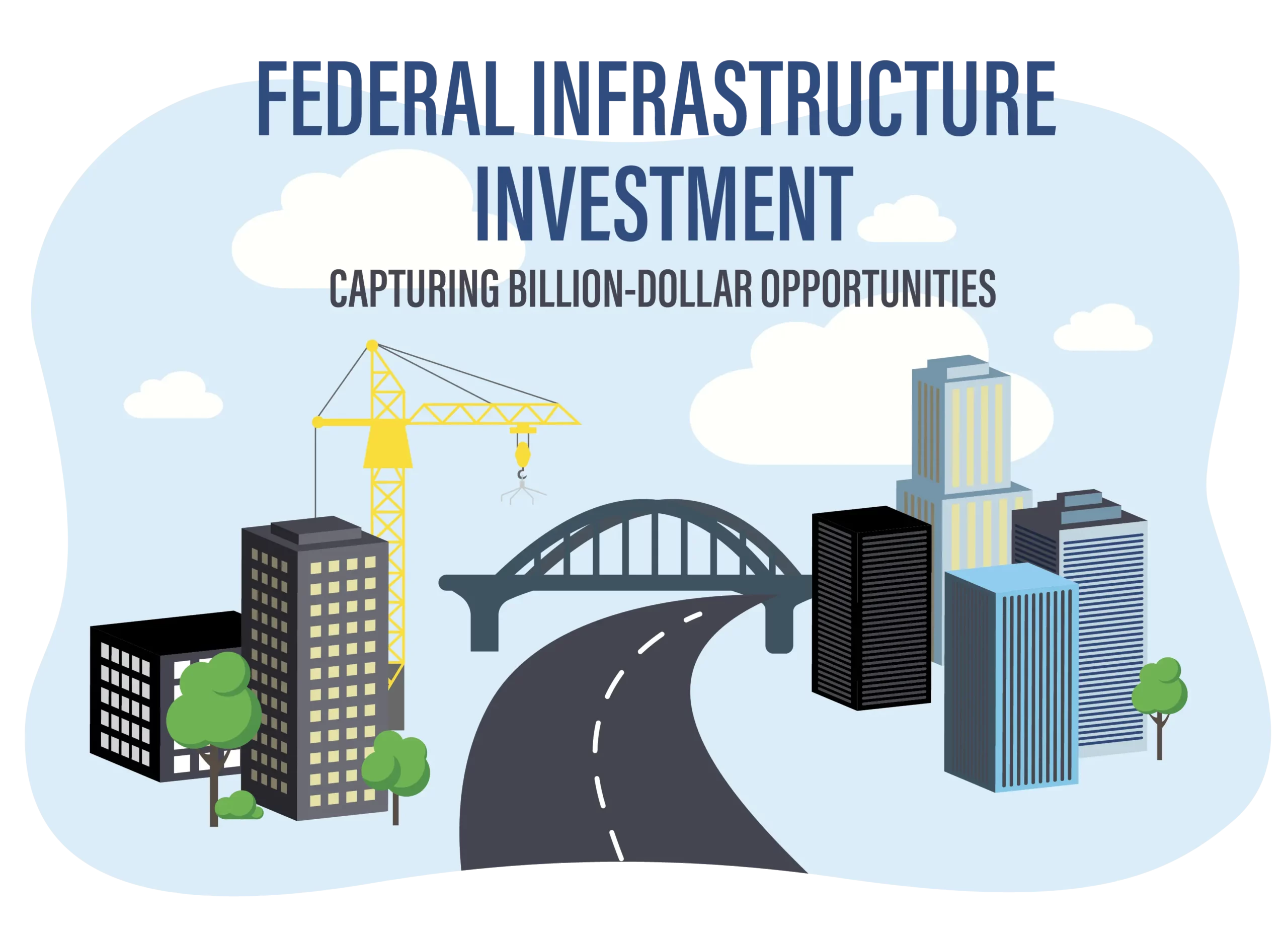Federal Infrastructure Investment: Capturing Billion-Dollar Opportunities

Here’s a sobering statistic that should make every architecture, engineering, and construction professional sit up straight: Canada faces a $270 billion infrastructure deficit, yet the Parliamentary Budget Office projects that our primary federal funding vehicle will only deploy $14.9 billion by 2027-28 — falling $20.1 billion short of its $35 billion target.
But here’s the twist that transforms this concerning reality into an unprecedented opportunity.
While traditional government funding mechanisms struggle with bureaucratic constraints and lengthy approval processes, the federal infrastructure landscape is experiencing a fundamental shift toward innovative financing models that prioritize speed, efficiency, and private sector collaboration.
This represents the largest infrastructure investment opportunity in Canadian history for professional services firms — if you know how to navigate it strategically.
Key Takeaways
- Canada’s federal infrastructure procurement landscape is evolving beyond traditional government contracts toward public-private partnerships worth billions annually.
- The Canada Infrastructure Bank has exceeded 100 investments and committed over $1 billion specifically to Indigenous-led infrastructure projects.
- Infrastructure Bank proposals now prioritize revenue-generating projects with private sector co-investment across five priority sectors.
- Critical minerals infrastructure funding was launched in March 2025, with $1.5 billion available until 2030 for enabling infrastructure.
- AI and data center demand are creating explosive growth in clean power and broadband infrastructure requirements.
- Federal funding applications increasingly favour firms demonstrating expertise in compliance, risk mitigation, and innovative financing structures.
The Seven-Point Federal Infrastructure Opportunity Framework
1. Understand the New Funding Ecosystem Beyond Traditional RFPs
The days of straightforward government-funded infrastructure projects are rapidly giving way to sophisticated financing arrangements that blend public objectives with private efficiency. The Canada Infrastructure Bank exemplifies this transformation, operating as a federal Crown corporation with $35 billion in investment capacity designed specifically to attract private sector and institutional investors.
Unlike traditional procurement, where government pays upfront and assumes all risks, today’s federal infrastructure RFP Canada opportunities increasingly involve revenue-generating projects where user fees, tolls, or service charges support long-term financing. This fundamental shift means successful firms must understand not just engineering and construction, but also project finance, risk allocation, and operational revenue models.
Consider BC Hydro’s recent RFP for 5,000 gigawatt-hours annually of clean electricity — equivalent to powering 500,000 homes. This isn’t a simple construction contract but a complex partnership requiring First Nations collaboration, private investment coordination, and long-term operational commitments. The winning consortiums will likely combine engineering expertise with financial structuring capabilities and Indigenous relationship management.
2. Master the Five Priority Sectors Where Billions Flow
The Canada Infrastructure Bank focuses its investments across five distinct priority areas, each with specific funding targets and selection criteria. Understanding these sectors isn’t just helpful — it’s essential for positioning your firm strategically.
- Green Infrastructure ($5 billion target)
encompasses energy-efficient building retrofits, water and wastewater systems, carbon capture and storage, clean fuels, and hydrogen projects. For architecture firms, this creates opportunities in large-scale building modernization programs. Engineering consultants can capitalize on the growing demand for sustainable urban systems and environmental remediation projects. - Clean Power ($5 billion target)
includes renewable energy generation, district energy systems, storage solutions, transmission infrastructure, and emerging small modular reactor projects. The sector experienced dramatic growth following the 2025 launch of enhanced federal tax credits for clean energy projects. - Public Transit ($5 billion target)
covers light rail systems, subway expansion, bus rapid transit, zero-emission bus fleets, and transit-oriented development. With over $76 billion in infrastructure projects expected to use public-private partnerships, transit represents the most significant near-term opportunity for A/E/C firms. - Trade and Transportation ($5 billion target)
encompasses ports, airports, freight corridors, highways, bridges, tunnels, passenger rail, and agriculture-related infrastructure. The recent focus on critical minerals supply chains has created particular demand for enabling transportation infrastructure in remote regions. - Broadband Infrastructure ($3 billion target)
addresses connectivity gaps in unserved and underserved communities, often requiring creative engineering solutions for challenging terrain and remote locations.
3. Navigate the Critical Minerals Infrastructure Bonanza
The March 2025 launch of the Critical Minerals Infrastructure Fund represents one of the most significant federal infrastructure opportunities for engineering and construction firms in decades. With $1.5 billion available until 2030, this program specifically targets enabling infrastructure for Canada’s critical minerals sector.
Unlike traditional resource development projects, critical minerals infrastructure funding recognizes that remote deposits require substantial supporting systems before extraction becomes viable. This creates opportunities for firms specializing in challenging terrain construction, remote area logistics, and innovative engineering solutions.
- Stream 1 (Preconstruction)
focuses on early-stage infrastructure development, including feasibility studies, environmental assessments, and preliminary engineering for projects that enable future critical minerals development. Engineering consultancies with expertise in remote area challenges and regulatory compliance find particular success in this stream. - Stream 2 (Shovel-Ready)
provides funding for construction-ready infrastructure projects that directly enable critical minerals extraction or processing. Construction firms with experience in challenging environments, specialized equipment mobilization, and Aboriginal consultation processes are well-positioned for these opportunities.
The fund’s coordination with the Canada Infrastructure Bank creates unique opportunities for innovative financing structures. Every CMIF application receives a CIB assessment for potential investment opportunities, potentially combining grant funding with low-cost financing for larger projects.
4. Leverage Public-Private Partnership Momentum
Public-private partnerships experienced explosive growth in 2025, with over $76 billion in infrastructure projects utilizing P3 models — representing the highest utilization rate in Canadian history. Eight of the twenty largest infrastructure projects now involve private funding or P3 arrangements.
This growth reflects governments’ recognition that traditional procurement models cannot address Canada’s infrastructure deficit within acceptable timeframes or budget constraints. Private sector involvement brings capital and operational expertise, innovation, and long-term asset management capabilities.
For professional services firms, P3 projects create opportunities to participate in long-term relationships rather than single-project engagements. Successful firms often evolve into preferred partners for major infrastructure developers, providing ongoing design, engineering, and consulting services across multiple projects and asset lifecycles.
However, P3 success requires understanding complex risk allocation, performance specifications, and outcome-based contracting. Firms must demonstrate capabilities in lifecycle asset management, not just initial design and construction.
5. Position for AI-Driven Infrastructure Demand
Artificial intelligence advancement creates unprecedented infrastructure demands, particularly for power generation and data center development. ChatGPT queries consume ten times more power than traditional internet searches, providing a glimpse into the massive infrastructure requirements as AI scales commercially.
Global data center demand could triple by 2030, driving significant investment in supporting infrastructure, including power generation, cooling systems, fibre optic networks, and specialized construction techniques. Alberta’s AI Data Center Strategy exemplifies provincial recognition of these opportunities.
For electrical engineers, this creates demand for sophisticated power management systems, redundant supply arrangements, and innovative cooling infrastructure. Mechanical engineers find opportunities in specialized HVAC systems, energy efficiency optimization, and sustainable facility design.
Civil engineering and construction firms benefit from data center development, which requires specialized foundation systems, environmental controls, and security infrastructure significantly more complex than traditional commercial construction.
6. Excel in Indigenous Partnership and Reconciliation
Federal infrastructure policy increasingly prioritizes Indigenous economic participation and partnership. The Canada Infrastructure Bank has already committed over $1 billion specifically to Indigenous-led infrastructure investments and exceeded its $1 billion Indigenous investment target ahead of schedule.
Budget 2023 announced CIB loans specifically designed to help Indigenous communities purchase equity stakes in infrastructure projects where the Bank also invests. This policy creates opportunities for firms that understand Indigenous consultation, partnership protocols, and community engagement requirements.
Successful federal funding applications demonstrate meaningful Indigenous participation from project conception through long-term operation. This goes beyond traditional consultation requirements to encompass genuine partnership arrangements, capacity building, and economic benefit sharing.
For A/E/C firms, this requires developing authentic relationships with Indigenous communities, understanding traditional territory considerations, and incorporating Indigenous knowledge systems into project design and implementation.
7. Master Advanced Compliance and Risk Management
Federal infrastructure projects increasingly involve complex regulatory environments, including cybersecurity requirements, environmental assessments, climate resilience standards, and international trade agreement compliance. The 2025 introduction of enhanced CMMC (Cybersecurity Maturity Model Certification) requirements for government contractors exemplifies this trend.
Firms pursuing Infrastructure Bank proposals must demonstrate sophisticated risk management capabilities, particularly for revenue-generating projects where operational performance directly affects financial returns. This includes understanding insurance requirements, performance guarantees, and long-term maintenance obligations.
Environmental compliance continues evolving with enhanced climate change considerations, biodiversity impact assessments, and sustainable development requirements. Projects must demonstrate alignment with Canada’s enhanced Nationally Determined Contribution of 40-45% emissions reduction below 2005 levels by 2030.
International trade agreement compliance (CETA, CPTPP, CUSMA) affects procurement processes, particularly for large infrastructure projects with significant foreign investment or component sourcing.
Industry-Specific Applications Across Professional Services
Architecture Firms benefit most from green infrastructure and public transit opportunities, particularly building retrofits, transit-oriented development, and sustainable community design projects. The CIB’s Infrastructure for Housing Initiative creates specific opportunities for firms with affordable housing and community planning expertise.
Engineering Consultancies find opportunities across all five priority sectors, with particular strength in clean power, trade and transportation, and broadband infrastructure. The critical minerals infrastructure fund creates exceptional opportunities for firms with expertise in remote areas and challenging terrain.
Construction Companies capitalize on the implementation phase of all federal infrastructure investments, but particularly benefit from understanding P3 procurement models and long-term asset management requirements that characterize Infrastructure Bank investments.
Risk Mitigation and Common Pitfalls
Federal infrastructure opportunities carry unique risks that require proactive management. Revenue-generating projects involve operational performance risks that extend decades beyond construction completion. Firms must understand long-term maintenance obligations, performance guarantees, and penalty provisions affecting project profitability throughout asset lifecycles.
Political risk remains significant, particularly for projects spanning multiple electoral cycles. Changes in government priorities can affect project approval timelines, funding conditions, or operational requirements. Successful firms develop projects with broad political appeal and clear economic benefits that transcend partisan considerations.
Regulatory compliance risks continue evolving as governments enhance environmental standards, cybersecurity requirements, and Indigenous consultation obligations. Firms that view compliance as a minimum requirement rather than a competitive advantage often encounter unexpected costs and delays that compromise project viability.
The Bottom Line: Transform Challenge Into Competitive Advantage
Canada’s infrastructure deficit represents our nation’s greatest business development opportunity for professional services firms. While traditional government funding mechanisms struggle with capacity constraints and bureaucratic inefficiencies, innovative financing models create pathways for firms that understand the new landscape.
The firms that thrive in this environment combine traditional technical expertise with a sophisticated understanding of project finance, risk management, and partnership development. They view federal infrastructure RFP Canada opportunities not as individual projects, but as entry points into long-term relationships with major infrastructure investors and public sector partners.
Success requires moving beyond traditional procurement thinking toward strategic partnership development. The most successful firms become preferred partners for major infrastructure developers, providing ongoing value across multiple projects and asset lifecycles rather than competing for individual contracts.
Ready to Capture Your Share of Billion-Dollar Opportunities?
Federal infrastructure investment represents a transformational opportunity for firms with the expertise and strategic vision to navigate this complex landscape effectively. But success requires more than technical capability — it demands a sophisticated understanding of innovative financing models, partnership development, and risk management that characterizes today’s infrastructure investment environment.
The Proposal Lab has guided over 250 clients through complex federal procurement processes, achieving a 35% win rate across 650+ proposals. Our deep expertise in Infrastructure Bank submissions, P3 procurement, and federal compliance requirements positions your firm to capitalize on unprecedented infrastructure investment opportunities.
Contact us today to discuss how we can transform your federal infrastructure capabilities from reactive proposal writing to strategic opportunity development. Let’s build your competitive advantage in Canada’s largest infrastructure investment wave.
